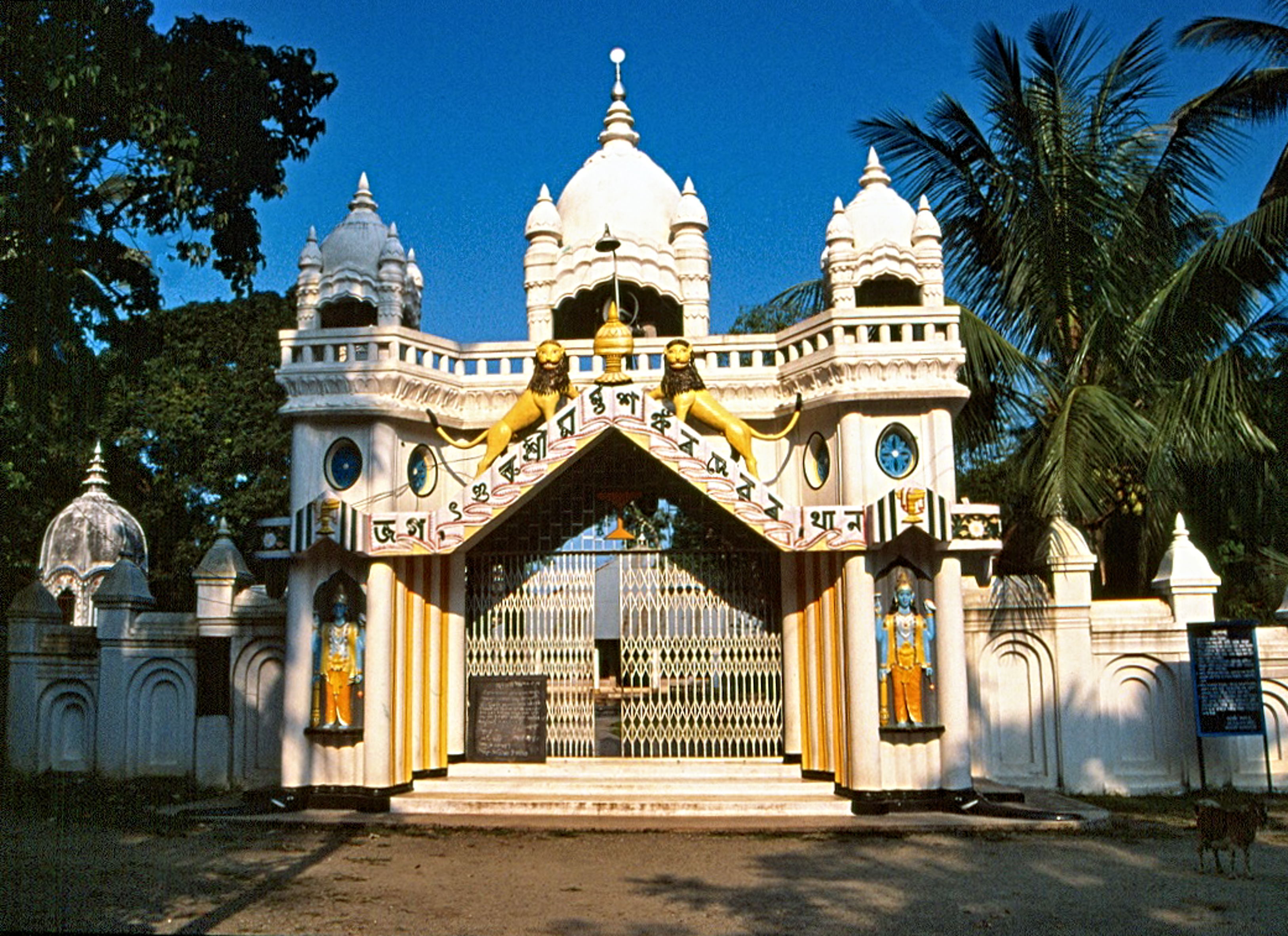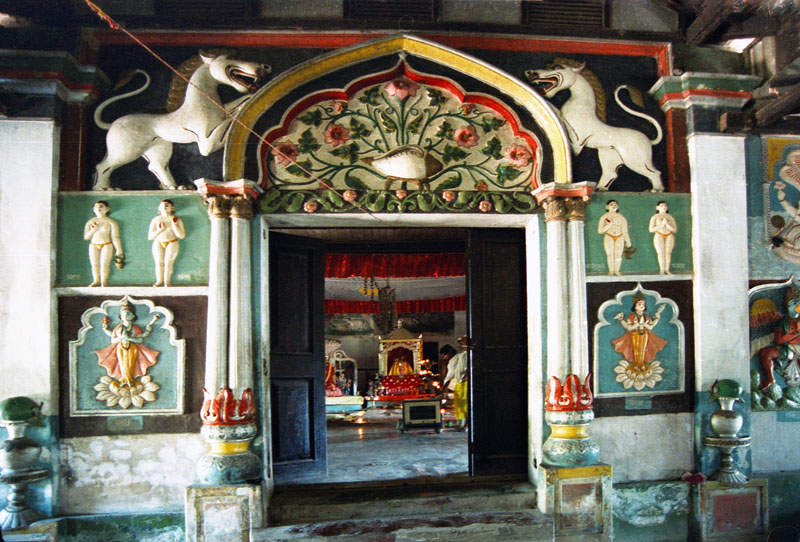|
Sankardev
Srimanta Sankardev( শ্ৰীমন্ত শংকৰদেৱ )(; ; 1449–1568) was a 15th–16th century Assamese polymath; a saint-scholar, poet, playwright, dancer, actor, musician, artist social-religious reformer and a figure of importance in the cultural and religious history of Assam, India. He is widely credited with building on past cultural relics and devising new forms of music (Borgeet), theatrical performance ( Ankia Naat, Bhaona), dance ( Sattriya), literary language (Brajavali). Besides, he has left an extensive literary oeuvre of trans-created scriptures ( Bhagavat of Sankardev), poetry and theological works written in Sanskrit, Assamese and Brajavali. The Bhagavatic religious movement he started, Ekasarana Dharma and also called Neo-Vaishnavite movement, influenced two medieval kingdoms – Koch and the Ahom kingdom – and the assembly of devotees he initiated evolved over time into monastic centers called Sattras, which continue to be important soc ... [...More Info...] [...Related Items...] OR: [Wikipedia] [Google] [Baidu] |
Ekasarana Dharma
Ekasarana Dharma (literally: ''Shelter-in-One religion'') is a neo-Vaishnavite monolithic religion propagated by Srimanta Sankardeva in the 15th-16th century in the Indian state of Assam. It reduced focus on vedic ritualism and focuses on devotion (''bhakti'') to Krishna in the form of congregational listening (''sravan'') and singing his name and deeds (''kirtan''). The simple and accessible religion attracted already Hindu as well as non-Hindu populations into its egalitarian fold. The neophytes continue to be inducted into the faith via an initiation ceremony called ''xoron-lowa'' (literally: take-shelter), usually conducted by ''Sattradhikars'', heads of monastic institutions called Sattras, who generally draw apostolic lineage from Sankardev. Some Sattradhikars, especially those from the Brahma-sanghati, reject apostolic lineage from Sankardev due to an early schism with the order. Some modern reformation institutions conduct ''xoron-lowa'' outside the ''sattra'' ins ... [...More Info...] [...Related Items...] OR: [Wikipedia] [Google] [Baidu] |
Madhavdev
Madhavdev (1489–1596) (Pron: ˈʃrɪ ˈʃrɪ ˈmɑ:dəbˌdeɪv) is an important preceptor of the Ekasarana Dharma known for his loyalty to his guru, Srimanta Sankardev as well as his artistic brilliance. Initially a sakta worshipper, he was converted to Ekasarana Dharma by Sankardev and became his most prominent disciple. He became the religious as well as artistic successor of Sankardeva after the latter's death in 1568. He is known particularly for his book of hymns, the Naam Ghosa, as well as a large selection of songs called ''Borgeets''. Biography Early life in adversity Madhavdev was born in May 1489 at Baligrama in Lakhimpur District of Assam to Govindagiri Bhuyan and Manorama. Govindagiri was a descendant of Hari Bhuyan one of the Bhuyan's who accompanied Candivara (Sankardev's forefather) in the 14th century as part of an exchange between Dharmanarayana of Gauda and Durlabhnarayan of Kamarupa-Kamata. Govindagiri became a Majinder at Banduka, (in Rangpur Distr ... [...More Info...] [...Related Items...] OR: [Wikipedia] [Google] [Baidu] |
Borgeet
Borgeets ( as, বৰগীত, lit=songs celestial, translit=Borgeet) are a collection of lyrical songs that are set to specific ragas but not necessarily to any tala (music), tala. These songs, composed by Srimanta Sankardeva and Madhavdeva in the 15th-16th centuries, are used to begin prayer services in Satra (Ekasarana Dharma), monasteries, e.g. Satra (Ekasarana Dharma), Satra and Namghar associated with the Ekasarana Dharma; and they also belong to the repertoire of Music of Meghalaya outside the religious context. They are a lyrical strain that express the religious sentiments of the poets reacting to different situations, and differ from other lyrics associated with the Ekasarana Dharma. Similar songs composed by others are not generally considered . The first Borgeet was composed by Srimanta Sankardeva during his first pilgrimage at Badrinath, Badrikashram in c1488, which is contemporaneous to the birth of Dhrupad in the court of Man Singh Tomar (1486-1518) of Gwalior. ... [...More Info...] [...Related Items...] OR: [Wikipedia] [Google] [Baidu] |
Sattra
Satras are institutional centers associated with the Ekasarana tradition of Vaishnavism, largely found in the Indian state of Assam and neighboring regions. Numbering in the hundreds, these centers are generally independent of each other and under the control of individual ''adhikaras'' (or ''satradhikars''), though they can be grouped into four different ''Sanghatis'' (orders). These centers, in the minimum, maintain a prayer house ('' Namghar'', or '' Kirtan-ghar''), initiate lay people into the Ekasarana tradition and include them as disciples of the Satra from whom taxes and other religious duties are extracted. The Neo-Vaishnavite satra culture started in the 16th century. They grew rapidly in the 17th century and patronage extended to them by first the Koch kingdom and later the Ahom kingdom was crucial in the spread the Ekasarana religion. Many of the larger Satras house hundreds of celibate and non-celibate ''bhakats'' (monks), hold vast lands and are repositories o ... [...More Info...] [...Related Items...] OR: [Wikipedia] [Google] [Baidu] |
Bhagavat Of Sankardev
The Bhagavat of Sankardev is the Assamese adaptation of the Bhagavata Purana made by Srimanta Sankardev in 15th-16th century in the regions that form present-day Assam and Cooch Behar. Though the major portions of the work was transcreated by Sankardev, a few other writers from that period contributed to the remaining sections. This book is revered and forms the central religious text for the followers of Sankardev (Ekasarana Dharma). The text is not a literal translation from the original Sanskrit into the vernacular but it is an adaptation to the local milieu in language and content. Sankardev's transcreation Srimanta Sankardev transcreated the different sections of the original Bhagavata Purana at different times of his life. They are: In the Bara Bhuyan territory # Book VI (''Ajamilopakhayana'' part) # Book VIII (''Amrta-manthana'' part): Sankardev omits the first and the last chapters of the original twenty-four chapters, and narrates four stories from the rest (''Gajend ... [...More Info...] [...Related Items...] OR: [Wikipedia] [Google] [Baidu] |
Bordowa Than
Batadrava than or bordowa than, bordowa for short is a holy pilgrimage site in Assam. Srimanta Sankardev was born in 1449 in Bordowa. Bordowa than is also a place of childhood, adolescence and career of Mahapurush Srimanta Sankardeva . The pilgrimage site is located at Batadrava, about 16 km from Nagaon city. In 1468, at the age of 19, Srimanta Sankaradev established sri sri Batadrava than in Bordowa. Another feature of Bordowa than is that it is the first Than or Namghar in the world founded by Sankaradev. And from here Sankardev spread Ekasarana Dharma all over India India, officially the Republic of India ( Hindi: ), is a country in South Asia. It is the seventh-largest country by area, the second-most populous country, and the most populous democracy in the world. Bounded by the Indian Ocean on the ... . Bordowa than covers an area of 286 bighas. History Satra Management Festivals and Events References {{reflist Hindu pilgrimage sites in India A ... [...More Info...] [...Related Items...] OR: [Wikipedia] [Google] [Baidu] |
Assam
Assam (; ) is a state in northeastern India, south of the eastern Himalayas along the Brahmaputra and Barak River valleys. Assam covers an area of . The state is bordered by Bhutan and Arunachal Pradesh to the north; Nagaland and Manipur to the east; Meghalaya, Tripura, Mizoram and Bangladesh to the south; and West Bengal to the west via the Siliguri Corridor, a wide strip of land that connects the state to the rest of India. Assamese language, Assamese and Boro language (India), Boro are the official languages of Assam, while Bengali language, Bengali is an additional official language in the Barak Valley. Assam is known for Assam tea and Assam silk. The state was the first site for Oil well, oil drilling in Asia. Assam is home to the one-horned Indian rhinoceros, along with the wild water buffalo, pygmy hog, tiger and various species of Asiatic birds, and provides one of the last wild habitats for the Asian elephant. The Economy of Assam, Assamese economy is aided by w ... [...More Info...] [...Related Items...] OR: [Wikipedia] [Google] [Baidu] |
Nagaon District
Nagaon is an administrative district in the Indian state of Assam. At the time of the 2011 census it was the most populous district in Assam, before Hojai district was split from it in 2016. History Batadrowa gave birth to the Vaishnavite reformer Sankardev, who brought about a renaissance in Assamese society. Located in Assam's heartland, Nagaon lies at the center of northeast India. The district dates to 1833. Its British administrators jocularly described Nagaon as a district of 3 C’s; namely: Chickens, Children and Cases. The region was called ''Khagarijan'' in older records. On 15 August 2016, the three tehsils of Nagaon district, namely Hojai, Doboka and Lanka were carved out to form the Hojai district. Geography The district headquarters are located at Nagaon. A part of the Kaziranga National Park is located within the Nagaon district. The district is bounded by the Brahmaputra river in the north (across the river is Sonitpur district, West Karbi Anglong di ... [...More Info...] [...Related Items...] OR: [Wikipedia] [Google] [Baidu] |
Sattriya
''Sattriya'' ( as, সত্ৰীয়া), or ''Sattriya Nritya'', is a major Indian classical dance. This dance was initially created as part of Bhaona which are performances of ''Ankiya Nat'', one-act plays, originally created by Sankardev, the 15th-16th century polymath from Assam.Ankiya Nat UNESCO: Asia-Pacific Database on Intangible Cultural Heritage (ICH), Japan These dances are part of the living traditions today of Sattras, which are communities of live-in devotees belonging to the , the religion established by Sankardev. [...More Info...] [...Related Items...] OR: [Wikipedia] [Google] [Baidu] |
Bhakti Movement
The Bhakti movement was a significant religious movement in medieval Hinduism that sought to bring religious reforms to all strata of society by adopting the method of devotion to achieve salvation. Originating in Tamilakam during 6th century CE, it gained prominence through the poems and teachings of the Vaishnava Alvars and Shaiva Nayanars before spreading northwards. It swept over east and north India from the 15th century onwards, reaching its zenith between the 15th and 17th century CE. The Bhakti movement regionally developed around different gods and goddesses, and some sub-sects were Shaivism ( Shiva), Vaishnavism ( Vishnu), Shaktism ( Shakti goddesses), and Smartism.Wendy Doniger (2009)"Bhakti" ''Encyclopædia Britannica'' Bhakti movement preached using the local languages so that the message reached the masses. The movement was inspired by many poet-saints, who championed a wide range of philosophical positions ranging from theistic dualism of Dvaita to abs ... [...More Info...] [...Related Items...] OR: [Wikipedia] [Google] [Baidu] |
Bhaona
Bhaona ( as, ভাওনা) is a traditional form of entertainment, with religious messages, prevalent is Assam, India. It is a creation of Mahapurusha Srimanta Sankardeva, written in the early sixteenth century. He created the form to convey religious messages to villagers through entertainment. Later Srimanta Madhavdeva also wrote some plays. The plays of bhaona are popularly known as Ankiya Nats and their staging is known as bhaona. Bhaona is generally staged at xatras and namghars in Assam. There are some special characteristics of Bhaona like the plays, dialogues, costumes, ornaments, entry and foot-steps of the characters. These characteristics helps to differentiate Bhaona from other plays. The bhaonas are written in the Assamese and Brajavali languages. In order to witness the Bhaona culture and traditions, one ought to visit Majuli, the largest river island in the world. Majuli receives a huge footfall of foreign tourists from all over the world every year. The na ... [...More Info...] [...Related Items...] OR: [Wikipedia] [Google] [Baidu] |




.jpg)
